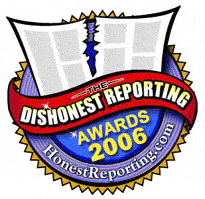 History won’t look back on 2006 as a pleasant year for Israel. We saw Hamas voted into power, Ariel Sharon crippled by a stroke, Qassams rain on Sderot, and the kidnappings of Gilad Shalit, Ehud Goldwasser and Eldad Regev. Our hearts and solidarity went out to one million northern Israelis forced to hunker down in bomb shelters for weeks. We saw too many senseless deaths, none more poignant than Daniel Wultz, Eliyahu Asheri, and the Taluzi brothers. Most of all, we’ll remember 2006 for Israel’s two-front war in Lebanon and Gaza.
History won’t look back on 2006 as a pleasant year for Israel. We saw Hamas voted into power, Ariel Sharon crippled by a stroke, Qassams rain on Sderot, and the kidnappings of Gilad Shalit, Ehud Goldwasser and Eldad Regev. Our hearts and solidarity went out to one million northern Israelis forced to hunker down in bomb shelters for weeks. We saw too many senseless deaths, none more poignant than Daniel Wultz, Eliyahu Asheri, and the Taluzi brothers. Most of all, we’ll remember 2006 for Israel’s two-front war in Lebanon and Gaza.
Our Dishonest Reporting awards primarily focus on fauxtography, the manipulated images, staged photos, and inaccurate captions that repeatedly tainted Mideast coverage. Space didn’t allow us to elaborate on many other noteworthy incidents of skewed reporting. Visual veracity was the issue of 2006.
Our intent is not to make sweeping generalizations about all photojournalists. Most are honest people admirably working under difficult conditions; many risk their lives to record history’s first draft. But important questions remain unanswered. What safeguards help editors detect altered images? Where do the rush of deadlines and the speed of technology leave the slower work of fact-checking? What do ethical standards, if any, say about posed shots? Were some photographers simply duped?
Foreshadow of the Year: Zoran Bozicevic
This National Post photo editor anticipated fauxtography days before war exploded in Gaza and Lebanon. As one dubious photo after another crept into the mainstream coverage, Jules Crittenden, a Boston Herald editor, validated Bozicevic Crittenden’s blunt assessment:
“Everyone in the news business gets taken for a ride sooner or later. It’s an occupational hazard. What is surprising is the scale of it in Lebanon. And what is tragic about this is, as a Boston Herald photo editor noted, editors everywhere can no longer trust the pictures from Lebanon. The public cannot know what is staged and what is real.”
Worst Director: Salem Daher, a.k.a. Abdel Qadar, a.k.a. “The Green Helmet Guy”
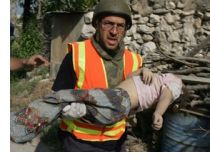 Though Daher insisted to AP that he’s just a Lebanese civil rescue worker, the German TV show ZAPP caught him directing other cameramen, posing for photos with casualties and having a body unnecessarily loaded into an ambulance a second time for better footage. ZAPP accused the ubiquitous Daher of abusing the dead. (Wikipedia clarifies the confusion over his name.)
Though Daher insisted to AP that he’s just a Lebanese civil rescue worker, the German TV show ZAPP caught him directing other cameramen, posing for photos with casualties and having a body unnecessarily loaded into an ambulance a second time for better footage. ZAPP accused the ubiquitous Daher of abusing the dead. (Wikipedia clarifies the confusion over his name.)
Worst Caption (newspaper): NYTimes
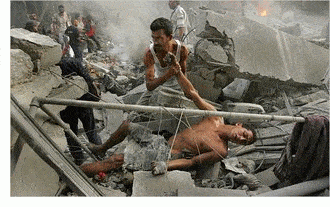 The NY Times was caught up in the fauxtography scandal thanks to a break down in the caption-writing process. This caption in a slide show suggested the man was dead. Bloggers wondered how a man killed in the strike could look so very much alive in the slide shows other images. Ironically, the Times had Hicks’ correct caption for the same photo in a separate report on July 27. The Times issued a correction and apologized to Hicks for the bungle. In October, Hicks explained to Photo District News his view of the affair.
The NY Times was caught up in the fauxtography scandal thanks to a break down in the caption-writing process. This caption in a slide show suggested the man was dead. Bloggers wondered how a man killed in the strike could look so very much alive in the slide shows other images. Ironically, the Times had Hicks’ correct caption for the same photo in a separate report on July 27. The Times issued a correction and apologized to Hicks for the bungle. In October, Hicks explained to Photo District News his view of the affair.
Worst Caption (magazine): Time
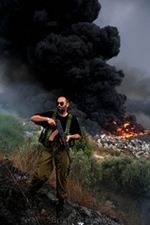 When a Hezbollah gunman was photographed near a billowing pillar of smoke, Time wrote a caption stating the fire was started by a downed Israeli jet. But Israel didn’t lose any aircraft over Lebanon. In fact, the fire was started by exploding Hezbollah rockets destroyed in an air strike.
When a Hezbollah gunman was photographed near a billowing pillar of smoke, Time wrote a caption stating the fire was started by a downed Israeli jet. But Israel didn’t lose any aircraft over Lebanon. In fact, the fire was started by exploding Hezbollah rockets destroyed in an air strike.
As other questions threatened to stain the reputation of photographer Bruno Stevens, he posted the story behind the photo on Lightstalkers. He included other notable facts and photos from the scene.
Worst Use of Props: BBC
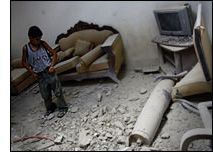 In this photo, a Lebanese child stands next to an unexploded Israeli shell. Is the child or the bomb the prop? BBC‘s Martin Asser explains that it was the boy:
In this photo, a Lebanese child stands next to an unexploded Israeli shell. Is the child or the bomb the prop? BBC‘s Martin Asser explains that it was the boy:
“When Um Ali Mihdi returned to her home in the southern Lebanese city of Bint Jbeil two days ago, she found a 1,000lb (450kg) Israeli bomb lying unexploded in her living room.The shell is huge, bigger than the young boy pushed forward to stand reluctantly next to it while we get our cameras out and record the scene for posterity.”
Worst Buzzword: “Disproportionate”
Although Israel’s air strikes were limited to Hezbollah targets, the word “disproportionate” became the standard catchphrase of criticism. Washington Post columnist Richard Cohen debunked the disproportionate use of that buzzword. After the war, it became clear that Israeli strikes were anything but disproportionate.
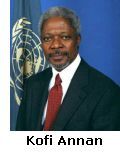 Retraction of the Year: Kofi Annan
Retraction of the Year: Kofi Annan
The outgoing UN Secretary General, who joined the global chorus unfairly blaming Israel for the Gaza Beach incident, to his credit, retracted criticisms of the IDF, saying he had responded to “media speculations.” We await retractions from those media speculators.
Canard of the Year (USA): Thomas Ricks of the Washington Post
Ricks accused Israel of deliberately leaving Hezbollah rockets intact for P.R. purposes. Appearing on CNN’s show, Reliable Sources, he said:
“Israel purposely has left pockets of Hezbollah rockets in Lebanon, because as long as they’re being rocketed, they can continue to have a sort of moral equivalency in their operations in Lebanon. It helps you with the moral high ground problem, because you know your operations in Lebanon are going to be killing civilians as well.”
Canard of the Year (Europe): Robert Fisk of the Independent
Rushing to judgment, Fisk declared Israel guilty of using uranium-based shells in Lebanon, though UN tests of soil samples were still in progress. The tests didn’t detect any unusual traces of uranium, but Independent buried the findings. We await a retraction.
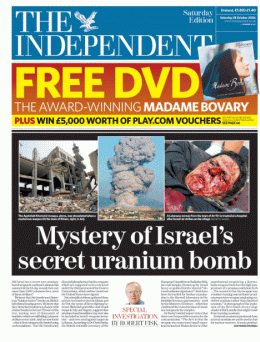
Sympathy for the Devil Award: CBC
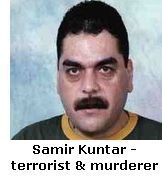 When the CBC aired a sympathetic interview with the family of Samir Quntar about the possibility of the Lebanese terrorists release in a prisoner swap, they all but ignored the brutal attack that landed him in an Israeli prison, and didn’t bother interviewing any relatives of his victims. After HonestReporting-Canada took action, the CBC followed up, interviewing Smadar Haran Kaiser, the woman whose family Samir Qantar murdered.
When the CBC aired a sympathetic interview with the family of Samir Quntar about the possibility of the Lebanese terrorists release in a prisoner swap, they all but ignored the brutal attack that landed him in an Israeli prison, and didn’t bother interviewing any relatives of his victims. After HonestReporting-Canada took action, the CBC followed up, interviewing Smadar Haran Kaiser, the woman whose family Samir Qantar murdered.
Worst Cartoon of the Year: Martin Rowson of the Guardian
The day after publishing this nasty cartoon, The Guardian apologized, but only because the Jewish stars in the illustration “might have been interpreted as implicating Judaism rather than the Israeli government in the present conflict.”
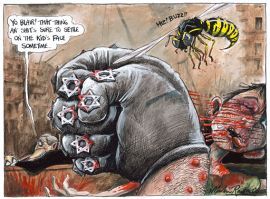
Worst News Executive: Dr. Snuki Zikalala of the SABC
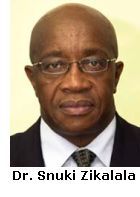 Dr. Zikalala, the news director of the South African Broadcasting Corp., gets this award for blacklisting various reporters, commentators and analysts. Though most personalities were banned for their views on South African politics, Paula Slier found herself blacklisted because her coverage of the Mideast conflict crossed Zikalala’s red lines. He wrote in a memo:
Dr. Zikalala, the news director of the South African Broadcasting Corp., gets this award for blacklisting various reporters, commentators and analysts. Though most personalities were banned for their views on South African politics, Paula Slier found herself blacklisted because her coverage of the Mideast conflict crossed Zikalala’s red lines. He wrote in a memo:
“From the movement where I come from, we support PLO. But she supported whats happening in Israel. I said no, you can’t you can’t undermine the Palestinian struggle, you can’t. For me it’s a principle issue.”
Worst Tangle of Media, Political & Judicial Interests: The French “Establishment”
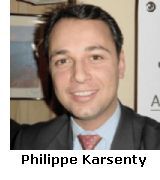 French media analyst Philippe Karsenty was found guilty of defaming France-2 TV and reporter Charles Enderlin for criticizing the network’s footage of Mohammed Dura. Karsenty, the founder and president of Media-Ratings discussed in an exclusive interview with HonestReporting how the trial touched on larger issues of anti-Zionism in the French media, the icon status of Mohammed Dura, Israel’s response to the affair, the disturbingly close relationship between French media and political elites, the fairness of French justice, even the role of the new France 24 international news station.
French media analyst Philippe Karsenty was found guilty of defaming France-2 TV and reporter Charles Enderlin for criticizing the network’s footage of Mohammed Dura. Karsenty, the founder and president of Media-Ratings discussed in an exclusive interview with HonestReporting how the trial touched on larger issues of anti-Zionism in the French media, the icon status of Mohammed Dura, Israel’s response to the affair, the disturbingly close relationship between French media and political elites, the fairness of French justice, even the role of the new France 24 international news station.
A parallel suit against Pierre Lurcat was dismissed on technical grounds. A third suit against Charles Gousz is yet to begin.
Worst Hypocrisy: Arab Cartoonists
We were struck by the Islamic rage over the Mohammed cartoons, while Arab cartoons are rife with demonizing anti-Semitism and Holocaust-denial.
Most Consistently Manufactured News Event: Bil’in
Broadway would envy the longevity and theatrics of the scripted clashes at Bil’in each Friday at the site of the security fence. One week, the “media event” even included Reuters’ participation.
Most Improbable Question of the Year: Is the BBC Pro-Israel?
 Read Martin Walker’s commentary to find out why the answer is no. If you’re still in doubt, consider the following: the BBC rejected key proposals put forward by the independent commission of inquiry, it stonewalls on Freedom of Information requests for the Balen report, and high level figures admit the Beeb is out of touch with viewers.
Read Martin Walker’s commentary to find out why the answer is no. If you’re still in doubt, consider the following: the BBC rejected key proposals put forward by the independent commission of inquiry, it stonewalls on Freedom of Information requests for the Balen report, and high level figures admit the Beeb is out of touch with viewers.
Dishonest Reporter of the Year: Adnan Hajj
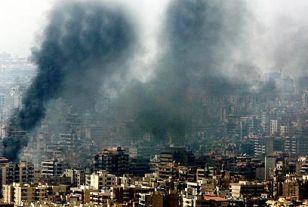 Working for Reuters, Hajj was caught poorly altering one photo of Beirut destruction and another of an Israeli jet firing flares. The doctored images – first spotted by Mike Thorson and blogged on Little Green Footballs – suggested a greater extent of Israeli destruction than really existed. Unlike other “fauxtographs,” the sloppiness of Hajj’s work suggested not a breakdown of procedure but deliberate doctoring.
Working for Reuters, Hajj was caught poorly altering one photo of Beirut destruction and another of an Israeli jet firing flares. The doctored images – first spotted by Mike Thorson and blogged on Little Green Footballs – suggested a greater extent of Israeli destruction than really existed. Unlike other “fauxtographs,” the sloppiness of Hajj’s work suggested not a breakdown of procedure but deliberate doctoring.
Hajj claimed he only used Photoshop to remove dust marks, but Reuters severed all ties with the photographer and removed all 920 of his photos from its database. The furor touched off the heightened scrutiny that led to our other ignoble honorees.
* * *
Hopefully, we’ll see in 2007 better safeguards preventing another “Photoshop of Horrors,” tighter caption-writing procedures, and clearer and enforced standards addressing posed photos. We also hope that the speed of digital photography and the rush of deadlines don’t rush past the needs of fact-checking.
We covered a lot of ground in 2006, and with the help of readers — our eyes and ears — we’ll continue monitoring the media in the coming year.

